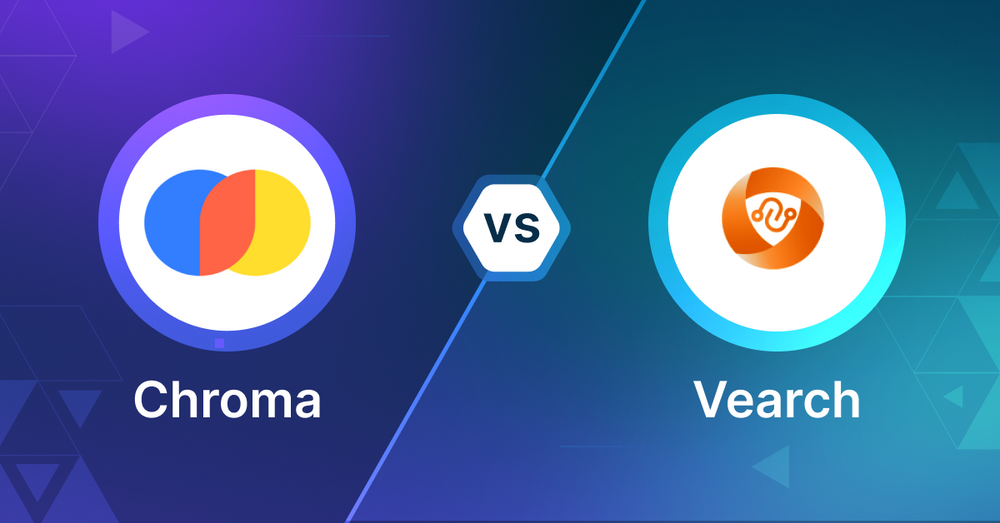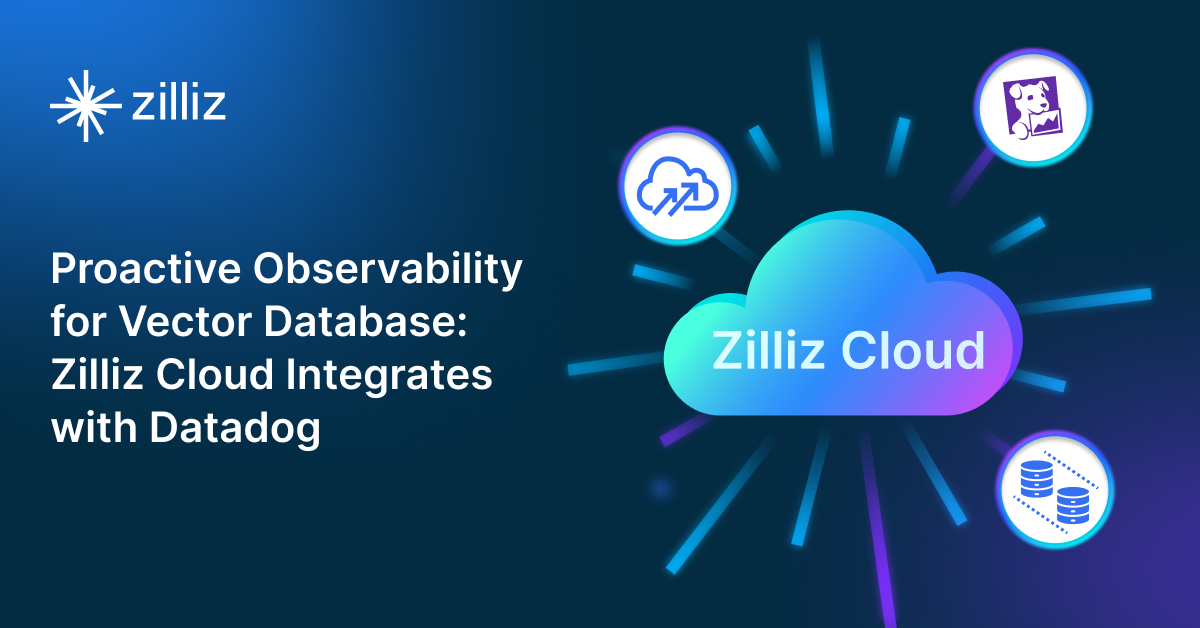Chroma vs Vearch: Choosing the Right Vector Database for Your Needs

As AI and data-driven technologies advance, selecting an appropriate vector database for your application is becoming increasingly important. Chroma and Vearch are two options in this space. This article compares these technologies to help you make an informed decision for your project.
What is a Vector Database?
Before we compare Chroma and Vearch, let's first explore the concept of vector databases.
A vector database is specifically designed to store and query high-dimensional vectors, which are numerical representations of unstructured data. These vectors encode complex information, such as the semantic meaning of text, the visual features of images, or product attributes. By enabling efficient similarity searches, vector databases play a role in AI applications, allowing for more advanced data analysis and retrieval.
Common use cases for vector databases include e-commerce product recommendations, content discovery platforms, anomaly detection in cybersecurity, medical image analysis, and natural language processing (NLP) tasks. They also play a role in Retrieval Augmented Generation (RAG), a technique that enhances the performance of large language models (LLMs) by providing external knowledge to reduce issues like AI hallucinations.
There are many types of vector databases available in the market, including:
- Purpose-built vector databases such as Milvus, Zilliz Cloud (fully managed Milvus)
- Vector search libraries such as Faiss and Annoy.
- Lightweight vector databases such as Chroma and Milvus Lite.
- Traditional databases with vector search add-ons capable of performing small-scale vector searches.
Meta Description: Chroma and Vearch are vector databases. This post compares their vector search capabilities.
What is Chroma? An Overview
Chroma is an open-source, AI-native vector database that simplifies the process of building AI applications. It acts as a bridge between large language models (LLMs) and the data they require to function effectively. Chroma's main objective is to make knowledge, facts, and skills easily accessible to LLMs, thereby streamlining the development of AI-powered applications. At its core, Chroma provides tools for managing vector data, allowing developers to store embeddings (vector representations of data) along with their associated metadata. This capability is crucial for many AI applications, as it enables efficient similarity searches and data retrieval based on vector relationships.
One of Chroma's key strengths is its focus on simplicity and developer productivity. The team behind Chroma has prioritized creating an intuitive interface that allows developers to quickly integrate vector search capabilities into their applications. This emphasis on ease of use doesn't come at the cost of performance. Chroma is designed to be fast and efficient, making it suitable for a wide range of applications. It operates as a server and offers first-party client SDKs for both Python and JavaScript/TypeScript, providing flexibility for developers to work in their preferred programming environment.
Chroma's functionality revolves around the concept of collections, which are groups of related embeddings. When adding documents to a Chroma collection, the system can automatically tokenize and embed them using a specified embedding function, or a default one if not provided. This process transforms raw data into vector representations that can be efficiently searched. Along with the embeddings, Chroma allows storage of metadata for each document, which can include additional information useful for filtering or organizing data. Chroma provides flexible querying options, allowing searches for similar documents using either vector embeddings or text queries, returning the closest matches based on vector similarity.
Chroma stands out in several ways. Its API is designed to be intuitive and easy to use, reducing the learning curve for developers new to vector databases. It supports various types of data and can work with different embedding models, allowing users to choose the best approach for their specific use case. Chroma is built to integrate seamlessly with other AI tools and frameworks, making it a good fit for complex AI pipelines. Additionally, Chroma's open-source nature (licensed under Apache 2.0) provides transparency and the potential for community-driven improvements and customizations. The Chroma team is actively working on enhancements, including plans for a managed service (Hosted Chroma) and various tooling improvements, indicating a commitment to ongoing development and support.
What is Vearch? An Overview
Vearch is a tool for developers building AI applications that need fast and efficient similarity searches. It’s like a supercharged database, but instead of storing regular data, it’s built to handle those tricky vector embeddings that power a lot of modern AI tech.
One of the coolest things about Vearch is its hybrid search. You can search by vectors (think finding similar images or text) and also filter by regular data like numbers or text. So you can do complex searches like “find products like this one, but only in the electronics category and under $500”. It’s fast too - we’re talking searching on a corpus of millions of vectors in milliseconds.
Vearch is designed to grow with your needs. It uses a cluster setup, like a team of computers working together. You have different types of nodes (master, router and partition server) that handle different jobs, from managing metadata to storing and computing data. This allows Vearch to scale out and be reliable as your data grows. You can add more machines to handle more data or traffic without breaking a sweat.
For developers, Vearch has some nice features that make life easier. You can add data to your index in real-time so your search results are always up-to-date. It supports multiple vector fields in a single document which is handy for complex data. There’s also a Python SDK for quick development and testing. Vearch is flexible with indexing methods (IVFPQ and HNSW) and supports both CPU and GPU versions so you can optimise for your specific hardware and use case. Whether you’re building a recommendation system, similar image search or any AI app that needs fast similarity matching, Vearch gives you the tools to make it happen efficiently.
Key Differences
Choosing between Chroma and Vearch for your vector search? Both serve a purpose in the vector database space but approach the problem differently. Let’s break down the main differences to help you decide for your project.
Search Methodology and Performance
Chroma takes a simple approach to vector similarity search, easy to use. It handles the embedding for you, so you can start searching your data without getting bogged down in the details. Whether you’re working with vector embeddings or searching with text queries, Chroma makes it easy.
Vearch, on the other hand, has more advanced search capabilities through its hybrid search system. This means you can combine vector similarity search with traditional database filtering - super powerful when you need complex queries. For example, you can search for similar products while applying filters for price ranges or categories. Vearch is particularly fast, with millisecond search times even with millions of vectors.
Data and Storage
Chroma’s data management is centered around collections, which are containers for related embeddings. Each item in a collection can store not only the vector embeddings but also metadata and the original documents. This makes it easy to organize and retrieve your data in a way that makes sense for your app.
Vearch takes a more flexible approach to data storage. It allows multiple vector fields per document and real-time indexing so your search results stay up to date as you add new data. Vearch has different indexing methods like IVFPQ and HNSW so you can optimize for your use case. This flexibility extends to handling both structured and unstructured data.
Scalability
When it comes to scaling, Chroma keeps it simple with a single server setup. This works well for smaller to medium sized apps where simplicity and ease of maintenance is key. The simplicity of this architecture means less operational overhead and easier management.
Vearch has a more complex but powerful distributed architecture. It has three types of nodes: master nodes for system management, router nodes for request handling and partition servers for data storage. This distributed approach is suitable for large scale deployments where you need to handle growing data and high performance.
Integrations
Chroma has strong integrations through its Python and JavaScript/TypeScript SDKs. These make it easy to add vector search to your existing apps. The system is designed to work with various AI tools and frameworks so it’s a good fit for AI heavy projects.
Vearch has similar integrations through its Python SDK but also allows you to use GPU for performance. This is particularly useful in high performance computing environments. If you don’t have GPU hardware, Vearch also has a CPU version that’s still pretty fast.
Usability
Chroma prioritizes developer experience with an API that’s easy to use and understand. The system handles many complex operations for you, including the embedding, so you can focus on building your app instead of the database. The documentation is clear and thorough so it’s easy to get started.
Vearch prioritizes flexibility and power over simplicity. This means more configuration options and advanced features but also a steeper learning curve. The distributed architecture requires more setup knowledge and ongoing maintenance. But this complexity gives you more control over how your system works.
Cost and Deployment
Chroma is open source under Apache 2.0 license with a managed service called Hosted Chroma coming soon. The simple architecture means lower operational costs and easier deployment. You don’t have to manage complex infrastructure which will save you time and money.
Vearch is also open source but requires more resources as a distributed system. You’ll need to manage multiple nodes and complex infrastructure which will increase operational costs. But if you need the extra features and scalability, then it might be worth it.
Chroma vs Vearch: A Practical Guide
When to Choose Chroma
Chroma is best when speed of implementation and ease of use are key. It’s perfect for startups and dev teams building AI applications that need vector search without infrastructure management. Chroma is great for projects that involve simple similarity searches like semantic document retrieval, content recommendation systems or AI powered search features where the dataset is small to medium. Automatic embedding and simple API makes it great for teams new to vector databases or working on rapid prototyping and MVP development.
When to Choose Vearch
Vearch is best when your application requires high performance hybrid search across large scale distributed data. It’s perfect for enterprise applications that need to combine traditional filtering with vector similarity search like e-commerce platforms that need product similarity search with price and category filters or large scale image recognition systems that need GPU acceleration. Vearch’s distributed architecture makes it the better choice for organizations that have the technical expertise to manage complex infrastructure and need to handle millions of vectors with millisecond level response time.
Conclusion
In the end it’s all about simplicity vs scalability and power. Chroma is great for developer experience and speed of implementation, perfect for teams that want to add vector search without infrastructure overhead. Its strength is in simplicity and integration with AI frameworks. Vearch requires more setup and maintenance but offers more performance and flexibility for large scale applications, especially when hybrid search and GPU acceleration is needed. Consider your team’s technical expertise, infrastructure and scaling requirements when making your decision - Chroma for faster development and simpler needs, Vearch for performance and complex search requirements at scale.
While this article provides an overview of Chroma and Vearch, it's key to evaluate these databases based on your specific use case. One tool that can assist in this process is VectorDBBench, an open-source benchmarking tool designed for comparing vector database performance. Ultimately, thorough benchmarking with specific datasets and query patterns will be essential in making an informed decision between these two powerful, yet distinct, approaches to vector search in distributed database systems.
Using Open-source VectorDBBench to Evaluate and Compare Vector Databases on Your Own
VectorDBBench is an open-source benchmarking tool designed for users who require high-performance data storage and retrieval systems, particularly vector databases. This tool allows users to test and compare the performance of different vector database systems such as Milvus and Zilliz Cloud (the managed Milvus) using their own datasets and determine the most suitable one for their use cases. Using VectorDBBench, users can make informed decisions based on the actual vector database performance rather than relying on marketing claims or anecdotal evidence.
VectorDBBench is written in Python and licensed under the MIT open-source license, meaning anyone can freely use, modify, and distribute it. The tool is actively maintained by a community of developers committed to improving its features and performance.
Download VectorDBBench from its GitHub repository to reproduce our benchmark results or obtain performance results on your own datasets.
Take a quick look at the performance of mainstream vector databases on the VectorDBBench Leaderboard.
Read the following blogs to learn more about vector database evaluation.
Further Resources about VectorDB, GenAI, and ML
- What is a Vector Database?
- What is Chroma**? An Overview**
- What is Vearch**? An Overview**
- Key Differences
- Search Methodology and Performance
- Data and Storage
- Scalability
- Integrations
- Usability
- Cost and Deployment
- When to Choose Chroma
- When to Choose Vearch
- Conclusion
- Using Open-source VectorDBBench to Evaluate and Compare Vector Databases on Your Own
- Further Resources about VectorDB, GenAI, and ML
Content
Start Free, Scale Easily
Try the fully-managed vector database built for your GenAI applications.
Try Zilliz Cloud for FreeKeep Reading

AI Agents Are Quietly Transforming E-Commerce — Here’s How
Discover how AI agents transform e-commerce with autonomous decision-making, enhanced product discovery, and vector search capabilities for today's retailers.

Zilliz Cloud Introduces Advanced BYOC-I Solution for Ultimate Enterprise Data Sovereignty
Explore Zilliz Cloud BYOC-I, the solution that balances AI innovation with data control, enabling secure deployments in finance, healthcare, and education sectors.

Proactive Monitoring for Vector Database: Zilliz Cloud Integrates with Datadog
we're excited to announce Zilliz Cloud's integration with Datadog, enabling comprehensive monitoring and observability for your vector database deployments with your favorite monitoring tool.
The Definitive Guide to Choosing a Vector Database
Overwhelmed by all the options? Learn key features to look for & how to evaluate with your own data. Choose with confidence.